Neurobiology of Trauma
and Treatment |
James
Kowal, M.S., LCPC |
| 3. NEUROBIOLOGICAL
MODEL OF MEMORY |
|
|
|
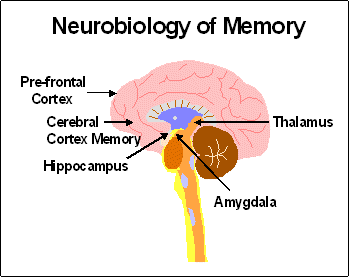 |
I will be
referring to certain components of the brain, primarily those indicated in this slide. The
limbic system, which includes the amygdala, hippocampus, and other
functional components, detects threats and regulates the fear
response in the human nervous system. It does so with information
obtained from the pre-frontal and cerebral cortex (memory). The
thalamus is the major switching system in the brain and routes the
signals of what we see, hear, feel, taste, and smell to appropriate
areas of the brain. Smell is an interesting sense, since it goes
directly |
|
to the cortex of the brain and then goes to the thalamus for routing. As a result, victims of trauma sometimes have
recurring experiences of the smells associated with the trauma. Smells can also be a
potent stimulus in recalling a traumatic event. |
|
We can view the brain as a
set of functional elements. All that we hear, feel, taste, see, and smell comes into the
thalamus. The thalamus then routes this information to many places. |
|
|
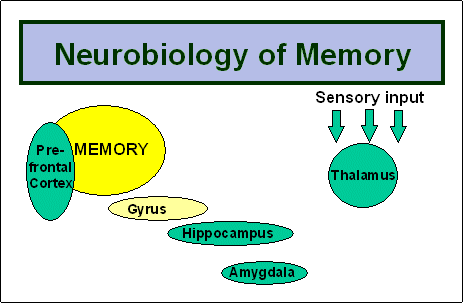
|
|
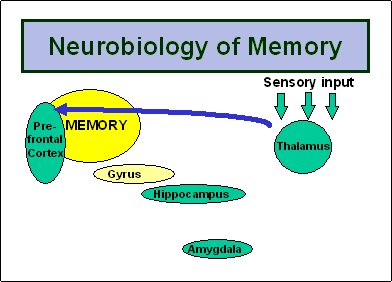 |
The first
and fastest signal the thalamus sends is to the pre-frontal cortex. The pre-frontal cortex
has access to the person’s entire memory. It first tries to determine if the person
has ever seen, heard, felt, tasted, or smelled this before. A pattern search immediately
takes place, trying to find a match in memory for any experience that resembles what is
occurring in the moment. |
|
|
Where there
is a match, information from the experience that was stored in memory, AND how the person felt about the event the last time it was experienced, are
immediately sent to the amygdala. The amygdala’s job is to determine what the significance is of what is happening to the person in the
moment. It is the fear center of the brain. Its job is to alert the nervous system if
there is any perceived threat to the person based on what is happening or on previous
related experiences. |
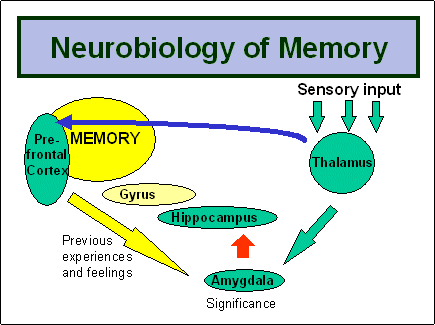 |
|
|
The amygdala obtains
information from the thalamus about what is happening in the moment and information from
the pre-frontal cortex about what has happened in the past AND how the person felt about
it the last time it happened. As it processes this information, the amygdala produces a
signal about the significance of what is currently happening and sends it to the
hippocampus. The hippocampus takes in all of the sensory information about what is
happening in the moment and determines where to store it based both on the direct sensory
information AND on its significance, as determined by the amygdala. |
|
 |
This is why
when a child gets bitten by a dog, the next time the child sees a dog (or anything
reminiscent of a dog), the memory of being bitten and how the child felt during that
experience comes rushing in. The amygdala immediately notifies the hippocampus and sounds
"the alarm" by sending a fear response up to the hippocampus. |
|
|
The
hippocampus takes into account what is happening and what the significance is and
determines where to store the information. If you think about this like a computer, the
hippocampus is the part of the brain that determines the address where it is going to
store the memory of what is happening at the moment. |
 |
|
|
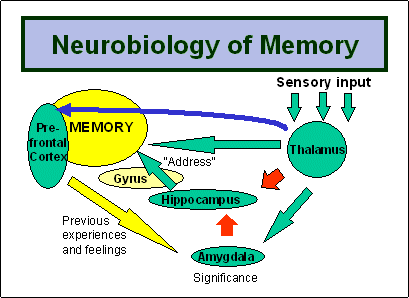 |
Once the location where the memory will be stored has been
determined, this information is passed on to the cerebral
cortex, through the cingulate gyrus. Information stored in the brain’s memory is not
organized chronologically. In fact, time is not stored in the brain’s memory per
se. To determine when an event occurred, the brain "figures
it out" by relating it to other events of significance, such as
moving from one house to another, one job to another, a
particular time in life, high school, college, before one is married, after one is
married, etc. |
|
|
How is memory
organized, if not chronologically? Certainly not alphabetically. It is organized by
affect. And the greater the fear the person feels while experiencing the event, the
greater the significance the amygdala assigns to the experience.
Jack Watkins (1997) developed a clinical
technique in the early 1970s called the "affect bridge." Observations from his
clients suggested that memories which have a similar affect are stored in related areas.
To help a client remember early emotional events, Jack would induce a trance and ask the
person to recall the last time he or she experienced the feeling being explored. Then, he
would direct the person to "follow that feeling, as if it is a rope you can hold in
your hands, leading you all the way back to the first time you experienced that
feeling." The person would often immediately go back to a childhood event whose
affect was similar to the more recent event. Once a person recalls an event that is
characterized by a particular emotion, the easier it becomes to recall other times when a
similar feeling was experienced. This is consistent with other evidence that memory is
organized by affect. |
|
|
|
|
|
 |
 |
|
 |
 |
|
|
|